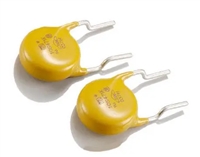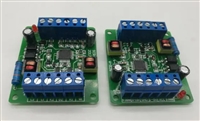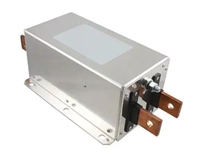The QT118H employs a hysteresis dropout below the
threshold level of 17% of the delta between the reference
and threshold levels.
2 - QT118H SPECIFICS
2.1 SIGNAL PROCESSING
The QT118H processes all signals using 16 bit precision,
using a number of algorithms pioneered by Quantum. The
algorithms are specifically designed to provide for high
survivability in the face of all kinds of adverse environmental
changes.
2.1.3 MAX
ON-DURATION
If an object or material obstructs the sense pad the signal
may rise enough to create a detection, preventing further
operation. To prevent this, the sensor includes a timer which
monitors detections. If a detection exceeds the timer setting,
the timer causes the sensor to perform a full recalibration.
This is known as the Max On-Duration feature.
2.1.1 DRIFT
COMPENSATION
ALGORITHM
Signal drift can occur because of changes in Cx and Cs over
time. It is crucial that drift be compensated for, otherwise
false detections, non-detections, and sensitivity shifts will
follow.
After the Max On-Duration interval, the sensor will once
again function normally, even if partially or fully obstructed,
to the best of its ability given electrode conditions. There are
two timeout durations available via strap option: 10 and 60
seconds.
Drift compensation (Figure 2-1) is performed by making the
reference level track the raw signal at a slow rate, but only
while there is no detection in effect. The rate of adjustment
must be performed slowly, otherwise legitimate detections
could be ignored. The QT118H drift compensates using a
slew-rate limited change to the reference level; the threshold
and hysteresis values are slaved to this reference.
Table 2-1 Output Mode Strap Options
Tie
Pin 3 to:
Tie
Pin 4 to:
Max On-
Duration
DC Out
DC Out
Toggle
Pulse
Vdd
Vdd
Gnd
Gnd
Vdd
Gnd
Gnd
Vdd
10s
60s
10s
10s
Once an object is sensed, the drift compensation
mechanism ceases since the signal is legitimately high, and
therefore should not cause the reference level to change.
The QT118H's drift compensation is 'asymmetric': the
reference level drift-compensates in one direction faster than
it does in the other. Specifically, it compensates faster for
decreasing signals than for increasing signals. Increasing
signals should not be compensated for quickly, since an
approaching finger could be compensated for partially or
entirely before even touching the sense pad. However, an
obstruction over the sense pad, for which the sensor has
already made full allowance for, could suddenly be removed
leaving the sensor with an artificially elevated reference level
and thus become insensitive to touch. In this latter case, the
sensor will compensate for the object's removal very quickly,
usually in only a few seconds.
2.1.4 DETECTION
I
NTEGRATOR
It is desirable to suppress detections generated by electrical
noise or from quick brushes with an object. To accomplish
this, the QT118H incorporates a detect integration counter
that increments with each detection until a limit is reached,
after which the output is activated. If no detection is sensed
prior to the final count, the counter is reset immediately to
zero. The required count is 4.
The Detection Integrator can also be viewed as a 'consensus'
filter, that requires four detections in four successive bursts
to create an output. As the basic burst spacing is 75ms, if
this spacing was maintained throughout all 4 counts the
2.1.2 THRESHOLD
CALCULATION
Unlike the QT110 device, the internal threshold level is fixed sensor would react very slowly. In the QT118H, after an
at one of two setting as determined by Table 1-1. These initial detection is sensed, the remaining three bursts are
setting are fixed with respect to the internal reference level, spaced about 18ms apart, so that the slowest reaction time
which in turn can move in accordance with the drift possible is 75+18+18+18 or 129ms and the fastest possible
compensation mechanism..
is 54ms, depending on where in the initial burst interval the
contact first occurred. The response time will thus average
92ms.
2.1.5 FORCED
S
ENSOR
R
ECALIBRATION
The QT118H has no recalibration pin; a forced recalibration
is accomplished only when the device is powered up.
However, the supply drain is so low it is a simple matter to
treat the entire IC as a controllable load; simply driving the
QT118H's Vdd pin directly from another logic gate or a
microprocessor port (Figure 2-2) will serve as both power
and 'forced recal'. The source resistance of most CMOS
gates and microprocessors is low enough to provide direct
power without any problems. Note that most 8051-based
microcontrollers have only a weak pullup drive capability
and will require true CMOS buffering. Any 74HC or 74AC
series gate can directly power the QT118H, as can most
other microcontrollers. A 0.01uF minimum bypass capacitor
close to the device is essential; without it the device can
Figure 2-2 Powering From a CMOS Port Pin
PORT X.m
0.01µF
C MO S
m ic rocontroller
Vdd
PORT X.n
OUT
QT118
Vss
lq
4






 一文带你了解压敏电阻器在直流电路中的过压保护作用
一文带你了解压敏电阻器在直流电路中的过压保护作用

 可控硅触发板选型指南
可控硅触发板选型指南

 蓝白可调电位器的原理与使用特点解析
蓝白可调电位器的原理与使用特点解析

 网络滤波器、EMI滤波器与EMC滤波器:分类关系与功能详解
网络滤波器、EMI滤波器与EMC滤波器:分类关系与功能详解
